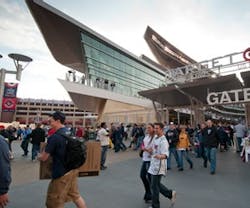UPPERCUT dual-flush flush valves stand up to Super Flush test—and masses of fans—at Minnesota’s Target Field.
Target Field, the contemporary, state-of-the-art, $545 million home of the Minnesota Twins Major League Baseball team, was designed aesthetically. Yet, the Park is also durable enough to contain the masses of fans who pile into the stadium at game time and then load the common areas during the seventh-inning stretch. Particularly in the restrooms, vandal-proof, water-efficient plumbing products were installed to meet the stadium’s high-traffic demands and sustainable building goals.
The UPPERCUT® dual-flush flushometer from Sloan Valve Company was one plumbing product that made the cut. To be exact, 610 flush valves were installed on the toilets and 286 flush valves were installed on the urinals for a total of 896 flush valves. The UPPERCUT dual-flush flushometer can reduce water volume by 30%, which calculates to a cost savings of at least $100,000 per year.
The calculation is based on average attendance plus restroom use per baseball season at Target Field with water closets flushing at the standard 1.6 gpf. Pushing the green handle down initiates a standard 1.6 gpf flush for solid waste and paper. Lifting the handle up initiates a reduced flush of 1.1 gpf for liquid and paper. Easy-to-understand instructions, etched on adhesive-backed metal plates, are included with every flushometer.
Before the stadium opened in April 2010 for the opening of the baseball season, the main domestic water and sanitary systems, including the Sloan UPPERCUT flushometers, were tested and put through a worse-case scenario that is known by some in the plumbing industry as the “Super Flush.” The Super Flush exercise ensures that the plumbing mains, both domestic water and sanitary, are intact and that the systems are functioning properly. The process is simulating a worse-case scenario with the highest flow under a very controlled situation, because at any time you can stop a test. Without testing the systems, it could be catastrophic.
The systems actually move under the flow. There is a lot of travel in everything. Pipes will shake and even buildings move. The Super Flush checks the city’s mains as well, testing the water delivery to the building. Question answered during the test are: Can the system, in fact, deliver a certain amount of gallons per minute through the main? And can the system discharge a certain number of gallons per minute of sanitary water back to the city’s system? The system works with pumps on variable frequency drives. The pumps ramp up and ramp down based upon demand.
At the greenest outdoor ballpark in America, according to the U.S. Green Building Council, which certified Target Field with LEED® Silver-level status, 150 people were part of the Super Flush test using 20% of the toilets and urinals. The flushing was timed through the use of the stadium public address system to coordinate. The flushing began very slowly with many seconds between flushes and was then tightened up with fewer flushes in between, adding rooms and floors until reaching the highest flow of about 2,000 gpm.
“The Super Flush is tested in many newly built stadiums to give the sanitary main system a test of the worse-case scenario, a scenario that most likely would never occur under normal circumstances,” says Kip Olson, piping coordinator/food service project manager on the Target Field project for Metropolitan Mechanical Contractors, Eden Prairie, Minn., which conducted the test of the entire plumbing system. “It all worked very well together during the test. It was a successful test and went off without any problems.”
